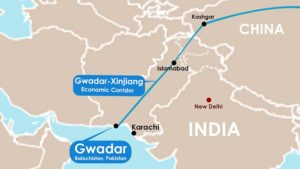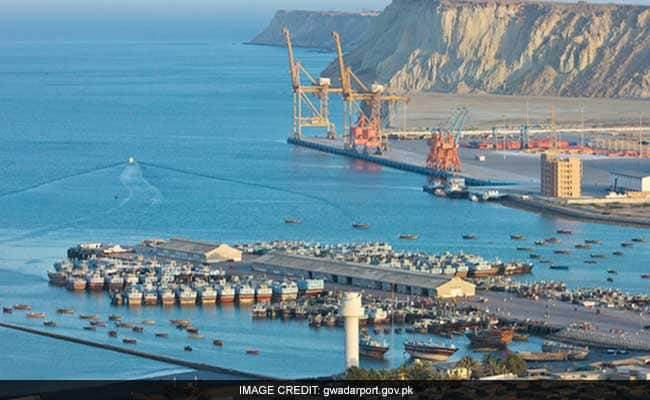Most of the world’s trade, both by volume and weight, is conducted through sea. Merchant ships in view of their bulk carrying capacity and low cost compared to other means of transportation, remain the most preferred platform for shipment of goods and seaports providing them loading and unloading facilities. Ports play an important role in strengthening the national economy and contributing significantly to the prosperity of the countries. Besides the economic gains, substantial political benefits can be extracted by providing seaport facilities to the regional countries especially land locked states. Development of a port also brings in its wake industrial development, prosperity and social uplift of immediate and adjoining areas. In 1990, 2.37 billion tons of cargo was moved through the world’s ports. In 2002, it reached a record high of 5.88 billion tons. This tremendous flow added over 10 percent of the national income for the majority of the world’s top economies.
The same is true for Pakistan as its GDP increased from $28.7 billion in 1983 to around $70 billion in 2003, and its dependence on sea trade increased to about 95 percent. Pakistan presently has only two commercial ports, Karachi and Bin Qasim, catering largely to the domestic needs. Pakistan’s sea-borne trade in the year 2000 was 42 million tons, and by 2015 the trade forecast is 78 million tons annually. Both the Karachi and Qasim ports are reaching their maximum cargo handling capacity and are likely to be deficient in meeting future demands. Strategically, the geographic location of Karachi port complex, hosting Karachi and Bin Qasim port, has certain inherent vulnerabilities, making it susceptible to Indian air and naval threat. These compulsions necessitate an additional port to meet future needs.
Realizing these constraints, the country has taken a giant step to build Gwadar Deep Sea port near the mouth of the oil rich Persian Gulf, which enhances its strategic importance. Besides domestic trade requirements, Gwadar port is suitably located to handle the trade of Western China, Afghanistan and in addition to provision of an economical route for the flow of natural resources of Central Asia.
Present Chinese commitment to build infrastructure such as construction of the Gwadar Port at the northern most tip of the Indian Ocean is seen by US as assertion of her long-term interest and propagates this as China’s ‘String of Pearls’ strategy that aims to project Chinese power overseas and protect China’s energy security. Apart from Gwadar, other pearls in China’s sea-lane strategy are facilities in Maldives, Bangladesh, Myanmar, Thailand, Cambodia and the South China Sea. The Indians and few other regional countries also share the US thought on the project.
The decision to develop the deep-sea port at Gawadar, made in 90’s and taken up in earnest by the present government, was dictated both by economic and strategic consideration. In addition, there is domestic dimension to it, since the project and under construction highway network would not only integrate hitherto isolated province of Baluchistan with the rest of the country but would also bring Pakistan in the mainstream of Central and South Western Asian commercial milieu. This link between East and West holds a promising future for Pakistan, as it will add significantly to the national economy.
With a population of 125,000, the Gwadar town on MakranCoast is now set on its way to become a hub of shipping, commercial and industrial activities. The construction work at the port started on 22 March 2002. The work on the first phase of this mega project, constructed by Chinese Harbour Engineering Company, is already complete. For this phase, out of a total cost of 248 million U.S. dollars, China has provided 198 million U.S. dollars in form of aid and soft loans while Pakistan provided 50 million U.S $.
The development of GwadarDeepSea port will be completed in two phases:
Phase-I
This phase includes construction of three berths, with a depth of 12.5 meters, and approach channels. On commissioning, these three berths will be used for the loading and unloading of general cargo that may come from as far as West China, Europe and the American continents. In the first phase, the 602 meter long quay/jetty will handle Bulk carrier up to 30,000 Deadweight Tonnage (DWT) and container vessel of 25000 DWT. Harbour work of phase I has already been completed by Chinese; however deepening of channel up to 14.5m is in progress.
Phase – II.
2nd Phase of the project is planned to be built on Built Operate & Transfer or Built Operate & Own (BOT /BOO) basis at an estimated cost of US$ 600 million. It will comprise nine additional berths including 4 Container Berths, 1 Bulk Cargo Terminal (to handle 100,000 DWT ships), 1 Grain Terminal, 1 Roll on/ Roll Off (Ro-Ro) Terminal and 2 Oil Terminals to handle 200,000 DWT ships.
Port Associated Infrastructure. While the construction work of port building is going on, a whole set of supporting infrastructure facilities is being laid down. The government has already established a Gwadar Development Authority that operates closely with the Gwadar Port Authority and other government agencies to synergize the completion of this mega project. Although the Gwadar Master Plan, placed at Annex A, encompasses majority of the short-term pre-requisites to run a major port, however, private sector is likely to play pivotal role in shaping the economic dynamics of the port.

Transportation Links. The Makran Coastal Highway linking Gawadar with Karachi on a 675-mile stretch is going to be lifeline of the Gawadar project. The highway was completed on 16 Dec 2004. This highway will open up the area for business opportunities to domestic as well as international investors. It will also link Karachi with Iran and, thus, open a new and shorter trade route between the two countries. The Asian Development Bank has already provided U.S. $500 million to build road projects, linking Baluchistan and Frontier provinces with Afghanistan and Central Asia. Road projects are, however, hitting snags due to persistent instability in Afghanistan and disturbed internal dynamics of Pakistan. There are also plans to lay a comprehensive rail link, along with a contemplated road network.
Up-gradation of the Gwadar Airport. Gwadar presently has a small airport that is basically meant for Fokker aircraft. Civil Aviation Authority plans to increase the runway from 5000ft to 15000 ft besides the approval of construction of a new Airport.
STRATEGIC SIGNIFICANCE OF GWADAR PORT
Military Aspect
The surest way of bringing a country to its knees, especially one, which is overwhelmingly dependent on sea borne trade, is to prevent its merchant shipping from plying the seas. During war, the requirement of petroleum products in Pakistan is expected to increase substantially. Additionally, the inflow of military spares and other associated provisions required for sustained military operations will also remain a controlling factor in the maintenance of the war stamina of Pakistan. Sea transportation being the ultimate solution to this problem requires due attention. Gwadar port, located on the West coast of Pakistan will not only shortens the Sea Lanes of Communications (SLOCs), but also will reduce the overseas transit of homebound convoys from the Gulf owing to geographical separation from the Karachi port complex.
The construction of GwadarPort has become all the more imperative in the view of the close proximity of Karachi and QasimPort, a factor that makes them both vulnerable to naval blockade by a hostile power. The need for an alternate port became apparent soon after the 1971 war, when the Karachi port complex came under Indian missile attack. The Gwadar port, 470 kilometers westward from Karachi, makes it difficult for the Indian Navy to achieve a naval blockade of Pakistan and will also serve as an alternate port to handle Pakistani trade in case of an emergency. On naval front, another major interest for Pakistan in the project is to seek strategic depth further to the southwest from its major naval base in Karachi that has long been vulnerable to the dominant Indian Navy, although Pakistan Navy has already constructed Jinnah Naval Base, which can address the naval concerns. In addition to being a commercial deep-sea port, Gwadar port can also be used as third naval base for Pakistan Navy. The government of Pakistan has designated the port area as a “sensitive defence zone.” Gwadar port can address Pakistan’s geo-strategic compulsions by providing sufficient air and naval threat warning time. It will also facilitate in dispersal of its vital assets in case of war and counter the strategic vulnerabilities in addition to monitoring the Indian shipping emanating from the Gulf to threaten Indian SLOCs for quid-pro-quo response if required.
3. Another critical security aspect is presence of country’s oil distribution system at Karachi only. The envisaged Gwadar port oil storage facility will certainly lessen our dependence on Karachi oil storage facility and will provide an alternate source when required.
Political Aspect
Gwadar is a coastal area where the local population largely depends upon fishing and sea related activities. The absence of proper infrastructure, lack of social development projects, limited economic opportunities and exposure to the relatively developed areas of Pakistan is a major cause of low poverty-stricken (55% below poverty line) and illiteracy rate(over 75%). If the slow economic growth, non-availability of infrastructure and dearth of resources were the foremost considerations that hampered the construction of Gwadar port in the earlier decades, then political instability in Baluchistan is a major cause of concern today. Tribal leaders, who have monopolized power in this backward province, are apprehensive of losing their hold over the people when the project materializes. The tribal chiefs like Sardar Akber Bugti, Khair Buksh Murree, Atta Ullah Mengal and other like-minded politicians are at the forefront in opposing this project. Although the reasons of their opposition to this project are more political than the technical, however, they are determined to check the progress on virtually all-ongoing Mega projects in Baluchistan.








